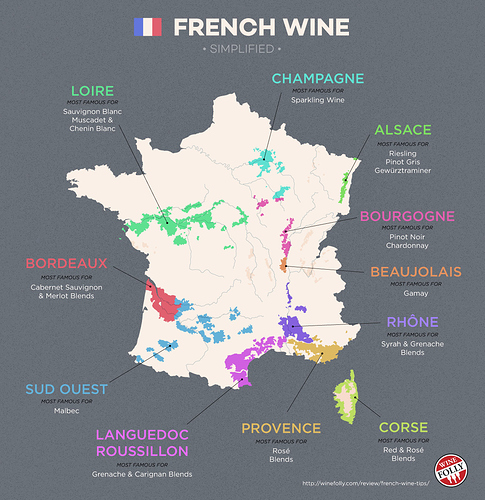We drink mostly Buzet red wines from our local area in Lot et Garonne. The predominant grapes are Merlot, Cabernet Franc & Cabernet Sauvignon. Most labels are a mixture of these three grapes. Sometimes you get 100% Merlot or Cabernet Sauvignon labels. Even a lot of the white wines from Buzet are mostly Merlot and Cabernet Franc grapes. Why would I buy other wines when ours are good value and the right taste! Mind you I don’t mind a present of a good Claret or Pinot Noir.
Anything red!
Probably the best wine region in France
Gaillac AOC is an Appellation d’Origine Contrôlée (AOC) in South West France in the département of Tarn, just north of Toulouse.[
The region makes claims to be among the earliest viticultural centres of ancient Gaul, though possibly after those of Languedoc around Narbonne, with wine production established in early 1st century.[2] Roman merchants transported wine to Bordeaux and Northern Europe down the Tarn River, and vineyards soon followed in the valley. Archaeologists have found Roman pottery in Montans.
The town of Gaillac grew up around a Benedictine monastery in the Middle Ages. As elsewhere, vineyards flourished in the care of the monks, who needed wine for religious purposes. In time the Counts of Toulouse gave Gaillac the right to put a rooster on the barrel in recognition of their wine.
Wines
The traditional red wines of the region are considered able to be kept for 8–10 years. They are made of the grape varieties Cabernet Franc, Cabernet Sauvignon, Duras, Fer Servadou or Syrah. On the Gaillac terroir, the variety Fer Servadou is known as Braucol. Rosé is made from the same grapes.
“Primeur” red wine is made for drinking young, it’s a marketing scheme based on Beaujolais Nouveau. The template is followed so closely that primeur wines must be made from the Gamay grape and are released for sale on the third Thursday of November.
The white wines are made of Mauzac, Sauvignon blanc or Muscadelle, Len de l’El and Ondenc, local grape varieties. Table wines, dessert wines and sparkling wines are all made.
Production
The vineyards cover 4,200 hectares (10,000 acres). The production is between 110-150,000 hl of red wine, 45-60,000 hl of white wine, and 20,000 hl of rosé.
Normally I prefer red, rosé or white
Nearly 20 years ago… we bought a bottle of wine to have with lunch… loved it so much, we raced back to Leclerc to buy some more. It was a Grenache-Syrah blend… a Leclerc special offer, cheap as chips, so we filled the boot. I soaked a label off a bottle, to help find the same wine since, without success. It may have been a one-off.
Anyway, we last drank some about 2 years ago and it was still delicious…mind you, we handled it with care. Not sure if the last bottle would be drinkable…so we’re keeping it just for old-time’s sake. 
Looking at your map James, we’ve drunk and enjoyed most varieties… and we are ready to go round again…hic…
seconded! and do my bit to support the local trade 
Only Loire Wines for me…apart from Picpoul de Pinet & Arbois (red).
Is one of those blue blotches Jurançon???
Yeah I reckon!
The map, I suppose inevitably, is pretty simplistic. For example there are actually 6 grape varieties allowed in Bordeaux and to limit SW red wines to Malbec is wrong - Madiran is based on Tannat mixed with Cabernet. Languedoc Roussillon, the biggest wine growing area has many, many grape varieties other than Grenache and Carignan. Not sure how useful it is. What counts is the skill of the winemaker.
